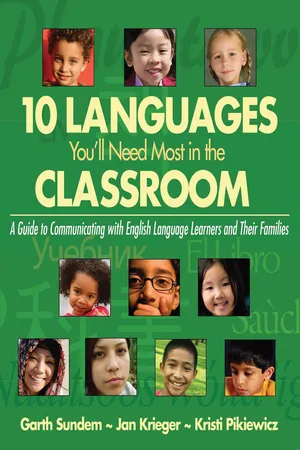
10 Languages You'll Need Most in the Classroom
A Guide to Communicating with English Language Learners and Their Families
- 288 pages
- English
- ePUB (mobile friendly)
- Available on iOS & Android
10 Languages You'll Need Most in the Classroom
A Guide to Communicating with English Language Learners and Their Families
About this book
Break through language barriers and put ELL students at ease in your classroom! More than ever before, K–12 educators in today's classrooms teach students from diverse language backgrounds. This handy reference guide to the ten most common languages of students who do not speak English—Spanish, Russian, Vietnamese, Arabic, Tagalog, Haitian Creole, Navajo, Hmong, Cantonese, and Korean—offers practical guidance for communicating with ELL students and their families. With a chapter dedicated to each language, this book provides a wealth of resources to help you make meaningful connections with ELL students, including: • Information about the traditions, religions, and celebrations of the family's country of origin
• Guides to common words and phrases in the student's native language
• Picture dictionaries that can be reproduced for use with students
• Sample parent letters that include both English and native language translations
• Basic reading tests in ten languagesLanguage can be an intimidating barrier to many students and teachers alike. Don't let it stand in the way of success. Help ensure that English Language Learners successfully transition into the school community and participate fully in the classroom learning environment!
Frequently asked questions
- Essential is ideal for learners and professionals who enjoy exploring a wide range of subjects. Access the Essential Library with 800,000+ trusted titles and best-sellers across business, personal growth, and the humanities. Includes unlimited reading time and Standard Read Aloud voice.
- Complete: Perfect for advanced learners and researchers needing full, unrestricted access. Unlock 1.4M+ books across hundreds of subjects, including academic and specialized titles. The Complete Plan also includes advanced features like Premium Read Aloud and Research Assistant.
Please note we cannot support devices running on iOS 13 and Android 7 or earlier. Learn more about using the app.
Information
| English | Spanish | Pronunciation Guide |
| Parents | Los padres | Los pah-drays |
| Mother | La madre | Lah mah-dray |
| Father | El padre | El pah-dray |
| Aunt | La tía | Lah tee-ah |
| Uncle | El tío | El tee-oh |
| Brother | El hermano | El air-mah-noh |
| Sister | La hermana | Lah air-mah-nah |
| Cousin | La prima/El primo | Lah pree-mah/El pree-moh |
| Grandfather | El abuelo | El ah-bway-loh |
| Grandmother | La abuela | Lah ah-bway-lah |
| Boyfriend/Girlfriend | El novio/La novia | El noh-vyoh/Lah noh-vyah |
| Whom do you live with? | ¿Con quién vives? | ¿Con kee-en vee-vays? |
| What is your phone number? | ¿Cuál es tu número de teléfono? | ¿Kwal es too noo-mair-oh day te-lay-foh-noh? |
| Please show this note to your ____. | Muéstrale esta nota a tu ____. | Mwes-trah-lay ays-tah noh-tah ah too ____. |
| Please get this signed, and bring it back. | Por favor haz firmar esto, y me lo devuelves. | Por fahv-or ahz feer-mar ays-toh, ee may loh de-vwel-ves. |
| Please have your ____ call me at school. | Dile a tu ____ que me llame a la escuela. | Dee-lay ah too ____ kay may yah-may ah lah es-kway-lah. |
| English | Spanish | Pronunciation Guide |
| Sit down, please. | Siéntate, por favor. | Syen-tah-tay, por fah-vor. |
| The assignment is on the board. | La tarea está en la pizarra. | Lah tah-ray-ah es-tah en lah pee-zah-rrah. |
| Pay attention! | ¡Presta atención! | ¡Pres-tah ah-ten-... |
Table of contents
- Cover
- Title Page
- Copyright
- Contents
- Preface
- Publisher’s Acknowledgments
- About the Authors
- Introduction
- 1. Spanish
- 2. Vietnamese
- 3. Hmong
- 4. Chinese (Cantonese)
- 5. Korean
- 6. Haitian Creole
- 7. Arabic
- 8. Russian
- 9. Tagalog
- 10. Navajo
- 11. Reading Tests
- References
- Additional Resources